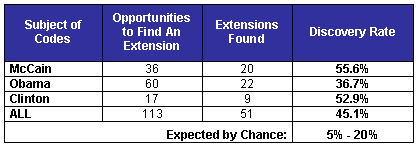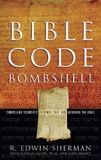| |
Startling Election Codes Surface
Part IV—Concluding Observations
What should we make of all this? The very high level of relevance of these codes to each of the presidential candidates is quite evident. The collection of 11 Obama codes is exceptionally on-target to current thinking and opinions. So, one would find it difficult to dismiss this collection as the makings of chance. If these codes were intentionally embedded in the Hebrew Bible, we cannot help but ask, "Why?"
Three possible explanations have been suggested for the reality of the phenomena of Bible codes. They were planted there to:
- Enable some decoder to predict the future.
- Provide strong evidence that the author(s) of the Bible knew the future when the Bible was written.
- Provide strong evidence that the content of the Bible is highly relevant to people and events of our time. In other words, the Bible is not just another ancient document of historical interest. Rather, the content of the Bible strongly interacts with, and is directly applicable to, life today.
One would be hard pressed to claim that the above collection of codes could serve as a reliable basis for making a prediction about the upcoming election. What these codes largely represent are opinions, or readily recognizable points-of-view, about the three main candidates.
On the other hand, the election codes presented in this article provide strong support for the second and third possible purposes of Bible codes. The absence of nonsense codes, which one would expect to comprise the bulk of this collection, if Bible codes were a chance thing, is striking. The persistent relevance of virtually all of these codes to the candidates is compelling.
Taken as a whole, the collection of extended codes found around the election terms presented in this article provides very strong evidence of the reality of the phenomenon of Bible codes. Out of the 113 opportunities that Dr. Jacobi had to discover a phrase as an extension to an existing ELS, he found one 45.1% of the time (51 out of 113). If this collection of Bible "codes" were the product of chance, the discovery rate would be around 20%, plus or minus a bit. For example, it might be 25% or 15%, but it would not be anything approaching 45%.

The 20% discovery rate is for extensions in good Hebrew, regardless of whether they make logical sense. The discovery rate for extensions in good Hebrew that are evidently relevant to the search term must be much smaller, say 5%. Virtually all, if not all, of the extensions found appear "relevant," so we are really comparing a discovery rate from a non-encoded text of 5% with the 45% discovery rate observed in this collection. It should be evident that we are not dealing with coincidence here.
|
Enjoy finding your own Bible codes.
Bible code search software is available in our online store.
Subscribe Free! Sign Up Today!
Become a member of the non-profit Isaac Newton Bible Code Research Society.
Not only will you be part of the world's leading organization researching and publicizing Bible and Torah codes, but you will receive Bible Code Digest absolutely free, including . . .
- Latest Bible Code News
- Easy-to-Understand Bible Code Feature Articles
- Exciting Inside Information from Leading Code Researchers
- Details of Great New Discoveries
- Summaries of the Latest Battles Between Code Proponents and Skeptics
Stay current on Bible code news. Be first to hear about all of the latest Bible code discoveries.
Sign up to receive Bible Code Digest today.
|
|


 
Bombshell examines two massive, recently discovered clusters of codes in the Hebrew Old Testament. To read more about Bombshell, click here, or click below to order from Amazon today!
 
|







